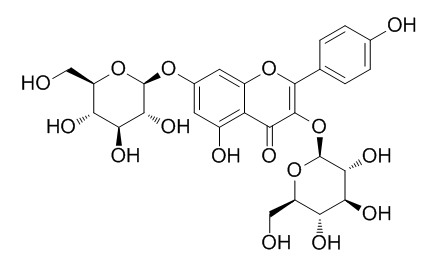Kaempferol 3,7-di-O-glucoside
Kaempferol 3,7-di-O-glucoside has antioxidant activity.
Inquire / Order:
manager@chemfaces.com
Technical Inquiries:
service@chemfaces.com
Tel:
+86-27-84237783
Fax:
+86-27-84254680
Address:
1 Building, No. 83, CheCheng Rd., Wuhan Economic and Technological Development Zone, Wuhan, Hubei 430056, PRC
Providing storage is as stated on the product vial and the vial is kept tightly sealed, the product can be stored for up to
24 months(2-8C).
Wherever possible, you should prepare and use solutions on the same day. However, if you need to make up stock solutions in advance, we recommend that you store the solution as aliquots in tightly sealed vials at -20C. Generally, these will be useable for up to two weeks. Before use, and prior to opening the vial we recommend that you allow your product to equilibrate to room temperature for at least 1 hour.
Need more advice on solubility, usage and handling? Please email to: service@chemfaces.com
The packaging of the product may have turned upside down during transportation, resulting in the natural compounds adhering to the neck or cap of the vial. take the vial out of its packaging and gently shake to let the compounds fall to the bottom of the vial. for liquid products, centrifuge at 200-500 RPM to gather the liquid at the bottom of the vial. try to avoid loss or contamination during handling.
Phytomedicine.2021, 83:153483.
Plant Foods Hum Nutr.2021, 76(4):472-477.
Int J Mol Sci.2020, 21(24):9369.
Brain Res Bull.2024, 218:111103.
Sci Rep. 2018, 1-9
Plants (Basel).2021, 10(5):951.
Int J Pharmacol2020, 16:1-9
ScientificWorldJournal.2022, 2022:4806889.
Int J Mol Sci.2020, 21(6):2190.
Bioorg Med Chem.2018, 26(14):4201-4208
Related and Featured Products
Food Chemistry, 2007, 105(3):1003-1010.
Chemical and antioxidative assessment of dietary turnip (Brassica rapa var. rapa L.)[Reference:
WebLink]
CONCLUSIONS:
The phenolic compounds and organic acids of turnip (Brassica rapa var. rapa L.) edible parts (leaves and stems, flower buds and roots) were determined by HPLC–DAD and HPLC–UV, respectively. The results revealed a profile composed of 14 phenolics (3-p-coumaroylquinic, caffeic, ferulic and sinapic acids, kaempferol 3-O-sophoroside-7-O-glucoside, kaempferol 3-O-sophoroside-7-O-sophoroside, kaempferol 3-O-(feruloyl/caffeoyl)-sophoroside-7-O-glucoside, kaempferol 3,7-O-diglucoside(Kaempferol 3,7-di-O-glucoside), isorhamnetin 3,7-O-diglucoside, kaempferol 3-O-sophoroside, 1,2-disinapoylgentiobiose, 1,2′-disinapoyl-2-feruloylgentiobiose, kaempferol 3-O-glucoside and isorhamnetin 3-O-glucoside) and six organic acids (aconitic, citric, ketoglutaric, malic, shikimic and fumaric acids). The quantification of the identified compounds showed kaempferol 3-O-sophoroside-7-O-glucoside, kaempferol 3-O-(feruloyl/caffeoyl)-sophoroside-7-O-glucoside, isorhamnetin 3,7-O-diglucoside and isorhamnetin 3-O-glucoside as the main phenolics, and malic acid as the organic acid present in highest amounts.
CONCLUSIONS:
A screening of the antioxidative potential was also performed by means of the DPPH radical scavenging assay. Turnip flower buds exhibited the strongest antioxidant capacity.
J Agric Food Chem. 2003 Apr 23;51(9):2438-46.
Characterization and content of flavonoid glycosides in genetically modified tomato (Lycopersicon esculentum) fruits.[Pubmed:
12696918 ]
There is a growing interest in producing food plants with increased amounts of flavonoids because of their potential health benefits. Tomatoes contain small amounts of flavonoids, most of which are located in the peel of the fruit. It has been shown that flavonoid accumulation in tomato flesh, and hence an overall increase in flavonoid levels in tomato fruit, can be achieved by means of simultaneous overexpression of the maize transcription factors LC and C1.
METHODS AND RESULTS:
Fruit from progeny of two modified lines (2027 and 2059) was selected for a detailed analysis and individual identification of flavonoids, at different stages of maturity. Nine major flavonoids were detected in the flesh of transgenic ripe tomatoes. LC/NMR, LC/MS, and LC/MS/MS enabled us to identify these as Kaempferol 3,7-di-O-glucoside (1), kaempferol-3-O-rutinoside-7-O-glucoside (2), two dihydrokaempferol-O-hexosides (3 and 4), rutin (5), kaempferol-3-O-rutinoside (6), kaempferol-3-O-glucoside (7), naringenin-7-O-glucoside (8) and naringenin chalcone (9), which were quantified by HPLC/DAD. All but 5, 6, and 9 were detected in tomato for the first time.
CONCLUSIONS:
The total flavonoid glycoside content of ripe transgenic tomatoes of line 2059 was about 10-fold higher than that of the controls, and kaempferol glycosides accounted for 60% of this. Kaempferol glycosides comprised around 5% of the flavonoid glycoside content of ripe control tomatoes (the rest was rutin and naringenin chalcone). The rutin concentration in both transgenic and control fruits was similar.



